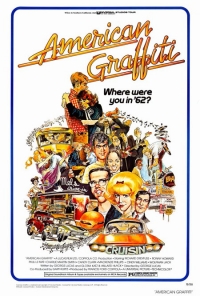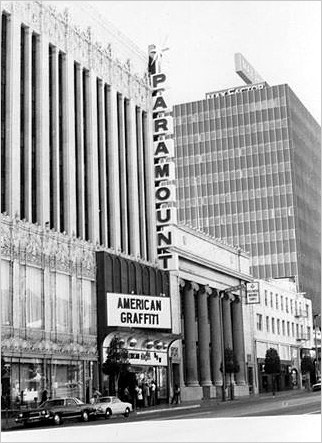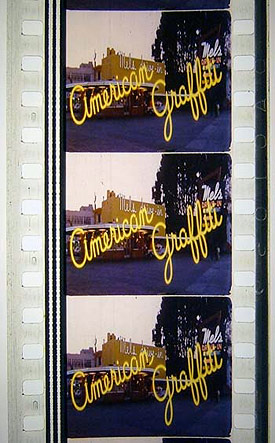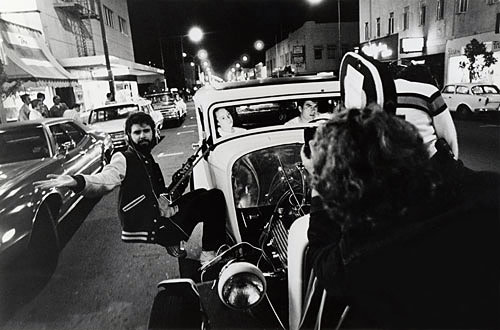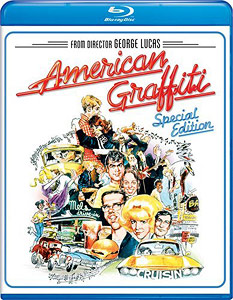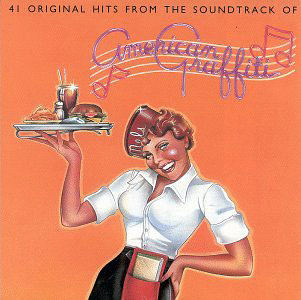THE ORIGINAL ENGAGEMENTS
This list of original theatrical engagements of American Graffiti represents the movie’s openings in (most of) the top 100 or so markets in the United States and Canada.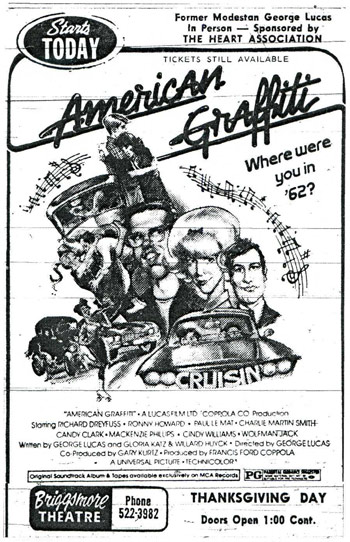
The list highlights the fascinating and somewhat mysterious nature of pre-saturation era film distribution and exhibition. As you may observe, the openings were staggered and not booked according to any population ranking, nor was there any consistency in regard to which markets showed the movie as a single-theater exclusive (initially at least) and those that ran it with multiple city/region-wide theaters.
Duration figures have not been included, but it should be mentioned that many of these engagements played several months with some playing over a year! (The longest-running engagement is cited in the “Did You Know?” section of this article.) By the end of its release, after playing a few thousand engagements, American Graffiti was Universal Pictures’ second-most successful movie.
The intent of this work, aside from creating historical record and to provide some nostalgia for those readers who saw the movie in its original release, is to clarify the numerous erroneous accounts about the movie’s release (and box-office performance) in books, articles and popular online movie resources. An erroneous release date even appeared in a book published by the company that made the movie! The film’s correct August 1st release date is often cited, but usually without the necessary context to clarify the staggered nature of its distribution. Historians and journalists have also frequently misrepresented the film’s box-office performance, usually due to confusing its gross earnings with rental earnings (the percentage of the gross paid to the distributor). As for the theaters in which the film played, a Universal Pictures executive was quoted in a Lucas biography that the film opened in Los Angeles at a theater not cited in the list and that he thought the presentation on a large screen was so poor that he demanded it be moved to a different, smaller theater, yet no evidence could be found of such an occurrence.
Anyway, with those issues in mind, please enjoy this look back at the original release of American Graffiti….
- 1973-08-01 … Los Angeles, CA – Avco Center Triplex
- 1973-08-12 … New York, NY – Sutton
- 1973-08-15 … Denver, CO – Colorado 4-Plex
- 1973-08-15 … Denver, CO – North Valley
- 1973-08-15 … Denver (Englewood), CO – Cinderella City
- 1973-08-15 … Denver (Lakewood), CO – Westland
- 1973-08-15 … Detroit (Bloomfield Hills), MI – Showcase Twin
- 1973-08-15 … Detroit (Dearborn), MI – Westborn
- 1973-08-15 … Detroit (Farmington Hills), MI – Old Orchard Twin
- 1973-08-15 … Detroit (Madison Heights), MI – Abbey Triplex
- 1973-08-15 … Detroit (Mt. Clemens), MI – Parkway Twin
- 1973-08-15 … Detroit (Oak Park), MI – Towne Twin
- 1973-08-15 … Detroit (Taylor), MI – Southland Twin
- 1973-08-15 … Detroit (Warren), MI – Warren 4-Plex
- 1973-08-15 … Detroit (Westland), MI – Quo Vadis Entertainment Center
- 1973-08-15 … Indianapolis, IN – Eastwood
- 1973-08-15 … Indianapolis, IN – Lafayette Square
- 1973-08-15 … Lansing (Okemos), MI – Meridian 4-Plex
- 1973-08-15 … Las Vegas, NV – Fox Boulevard
- 1973-08-15 … Orange (Costa Mesa), CA – South Coast Plaza Twin
- 1973-08-15 … Orange (Santa Ana), CA – Harbor Blvd. Drive-In
- 1973-08-15 … San Diego, CA – Loma
- 1973-08-15 … San Francisco, CA – Cinema 21
- 1973-08-15 … Tucson, AZ – Buena Vista Twin
- 1973-08-15 … Tulsa, OK – Fontana 4-Plex
- 1973-08-16 … Omaha, NE – Six West 6-Plex
- 1973-08-16 … Omaha (Ralston), NE – Park 4-Plex
- 1973-08-17 … Atlanta, GA – Fine Art
- 1973-08-17 … Dallas, TX – Medallion
- 1973-08-17 … Houston, TX – Alabama
- 1973-08-17 … Lincoln, NE – Plaza 4-Plex
- 1973-08-17 … Louisville, KY – Penthouse
- 1973-08-22 … Buffalo (Amherst), NY – Boulevard Mall Twin
- 1973-08-22 … Buffalo (Cheektowaga), NY – Holiday 6-Plex
- 1973-08-22 … Honolulu, HI – Waikiki Twin
- 1973-08-22 … Milwaukee, WI – Northridge Triplex
- 1973-08-22 … Milwaukee (Greendale), WI – Southridge Triplex
- 1973-08-22 … Milwaukee (West Allis), WI – Westlane
- 1973-08-22 … Oklahoma City, OK – North Park 4-Plex
- 1973-08-22 … Sacramento, CA – Century 21
- 1973-08-22 … Salt Lake City (South Salt Lake), UT – Century 23
- 1973-08-22 … San Jose, CA – Century 22 Triplex
- 1973-08-24 … Chicago, IL – Ford City Twin
- 1973-08-24 … Chicago, IL – Marina Triplex
- 1973-08-24 … Chicago (Evanston), IL – Evanston
- 1973-08-24 … Chicago (Lombard), IL – Yorktown Twin
- 1973-08-24 … Chicago (Merrillville, IN), IL – Crossroads Twin
- 1973-08-24 … Chicago (Niles), IL – Golf Mill Triplex
- 1973-08-24 … Oakland, CA – Theatre 70
- 1973-08-24 … Oakland (Hayward), CA – Southland Twin
- 1973-08-24 … Portland, OR – Broadway
- 1973-08-24 … Seattle (Renton), WA – Renton Village Twin
- 1973-08-29 … Austin, TX – Fox Twin
- 1973-08-29 … Cincinnati, OH – Skywalk Twin
- 1973-08-29 … Des Moines, IA – Fleur 4-Plex
- 1973-08-29 … Des Moines (West Des Moines), IA – Sierra Triplex
- 1973-08-29 … Kansas City (Overland Park, KS), MO – Glenwood Twin
- 1973-08-29 … Kansas City (Raytown), MO – Brywood 5-Plex
- 1973-08-29 … Rochester (Greece), NY – Stoneridge Twin
- 1973-08-31 … Baltimore, MD – Senator
- 1973-08-31 … Baltimore (Randallstown), MD – Liberty Twin
- 1973-08-31 … Baltimore (Woodlawn), MD – Security Square Twin
- 1973-08-31 … Dayton (Trotwood), OH – Salem Mall Twin
- 1973-08-31 … San Antonio, TX – Fox Central Park Twin
- 1973-08-31 … Washington, DC – Embassy
- 1973-09-21 … Albuquerque, NM – Fox Winrock
- 1973-09-21 … Boston, MA – Cheri Triplex
- 1973-09-21 … Cleveland (Mayfield Heights), OH – Mayland Twin
- 1973-09-21 … Cleveland (Parma), OH – Parmatown Triplex
- 1973-09-21 … Minneapolis, MN – Skyway Twin
- 1973-09-21 … New Orleans, LA – Joy
- 1973-09-21 … Phoenix (Scottsdale), AZ – Kachina
- 1973-09-21 … St. Paul, MN – Norstar
- 1973-09-28 … Albany, NY – Hellman
- 1973-09-28 … Cedar Rapids, IA– Stage 4-Plex
- 1973-09-28 … Columbus, OH – Morse Road
- 1973-09-28 … El Paso, TX – Northgate
- 1973-09-28 … Grand Rapids, MI – Alpine Twin
- 1973-09-28 … Lubbock, TX – Fox Twin
- 1973-09-28 … Memphis, TN – Plaza Twin
- 1973-09-28 … Philadelphia, PA – SamEric
- 1973-09-28 … Stockton, CA – Sherwood Plaza
- 1973-09-28 … Syracuse (DeWitt), NY – Shoppingtown Twin
- 1973-09-28 … Tacoma (Lakewood), WA – Villa Plaza Twin
- 1973-09-28 … Toledo, OH – Showcase Triplex
- 1973-09-28 … Virginia Beach (Norfolk), VA – JANAF
- 1973-10-05 … Toronto, ON – Uptown 5-Plex
- 1973-10-05 … Vancouver, BC – Varsity
- 1973-10-12 … Edmonton, AB – Varscona
- 1973-10-12 … Montreal, QC – York
- 1973-10-17 … Pittsburgh, PA – Chatham
- 1973-10-19 … Baton Rouge, LA – University 4-Plex
- 1973-10-19 … Madison, WI – Strand
- 1973-10-19 … Nashville, TN – Green Hills
- 1973-10-19 … Providence (East Providence), RI – Four Seasons 4-Plex
- 1973-10-19 … Providence (Warwick), RI – Warwick Mall Twin
- 1973-10-19 … St. Louis (Maryland Heights), MO – Westport Twin
- 1973-10-19 … Spokane, WA – Dishman
- 1973-10-19 … Springfield, MA – Eastfield Mall
- 1973-10-19 … Springfield (West Springfield), MA – Paris
- 1973-10-19 … Worcester, MA – Lincoln Plaza
- 1973-10-19 … Youngstown, OH – Uptown
- 1973-10-26 … Calgary, AB – Towne
- 1973-10-26 … Charlotte, NC – Park Terrace
- 1973-10-26 … Fort Worth, TX – Ridglea
- 1973-10-26 … Harrisburg, PA – Union Deposit Twin
- 1973-10-26 … Miami (Coral Gables), FL – Miracle
- 1973-10-26 … Miami (Fort Lauderdale), FL – Gateway
- 1973-10-26 … Miami (North Miami Beach), FL – 163rd Street
- 1973-10-26 … Ogden (South Ogden), UT – Wilshire
- 1973-10-26 … Raleigh, NC – State
- 1973-10-26 … St. Petersburg, FL – Crossroads
- 1973-10-26 … Tampa, FL – Floriland Twin
- 1973-10-26 … Tampa, FL – Twin Bays 4-Plex
- 1973-10-26 … Winnipeg, MB – Polo Park
- 1973-11-02 … Birmingham, AL – Village East Twin
- 1973-11-02 … Charleston, SC– Ultravision
- 1973-11-02 … Fresno, CA – Country Squire
- 1973-11-02 … Jacksonville, FL – Edgewood
- 1973-11-02 … Orlando, FL – Plaza Twin
- 1973-11-02 … Ottawa, ON – Elgin Twin
- 1973-11-02 … Reno, NV – Cinema
- 1973-11-02 … Richmond, VA – Westhampton
- 1973-11-09 … Billings, MT – Cine Triplex
- 1973-11-09 … Charleston, WV– Village
- 1973-11-09 … Colorado Springs, CO – Cooper Triplex
- 1973-11-09 … Durham, NC – Carolina
- 1973-11-09 … Lexington, KY – Turfland Mall
- 1973-11-09 … Mobile, AL – Village Triplex
- 1973-11-09 … Portland (Westbrook), ME – Cinema City
- 1973-11-09 … Springfield, MO – Tower
- 1973-11-16 … Corpus Christi, TX – Cine West Twin
- 1973-11-16 … Fayetteville, NC – Miracle
- 1973-11-21 … Modesto, CA – Briggsmore
- 1973-11-21 … Winston-Salem, NC – Thruway
- 1973-12-21 … Bakersfield, CA – Valley Plaza
- 1973-12-21 … Hartford (East Hartford), CT – Showcase 4-Plex
- 1973-12-21 … Lakeland, FL – Imperial Mall Twin
- 1973-12-21 … New Haven (Orange), CT – Showcase 4-Plex
- 1973-12-21 … Wichita KS – Fox
- 1974-01-18 … Greensboro, NC – Terrace
- 1974-01-31 … Augusta, GA – National Hills
A SAMPLING OF MOVIE REVIEWER QUOTES
“Without exception, all players fit perfectly into the concept and execution, and all the young principals and featured players have a bright and lengthy future. And so does Lucas.” — A.D. Murphy, Variety
“Four stars. Highest rating! Warm, funny and poignant. It is a richly entertaining film guaranteed to please nearly everyone. By all means, go and enjoy it!” — Kathleen Carroll, New York Daily News
“The warmest, most human comedy in a long time…masterfully executed…profoundly affecting…sensationally funny.” — Charles Champlin, Los Angeles Times
“[American Graffiti] is without doubt the most tedious film I have ever seen. Whole new vistas of boredom wide-screen open to the imagination after this breakthrough. The excessive footage on the cars is wearisome in the extreme. Grand Prix it isn’t.” — Anitra Earle, San Francisco Chronicle
“A happy new movie…should brighten the lives of moviegoers…everything about American Graffiti is so good!” — George Anderson, Pittsburgh Post-Gazette
“Easily the best movie so far this year.” — Stephen Farber, The New York Times
“Superb!” — Jay Cocks, Time
“With American Graffiti, his second feature film, 29-year-old George Lucas demonstrates that commerce can, on rare occasion, prove to be a comfortable bedfellow for art” — Susan Stark, Detroit Free Press
“American Graffiti is an instant classic, a rare work of genius, and a strong contender for the best picture of this or any other year award!!” — The Birmingham News
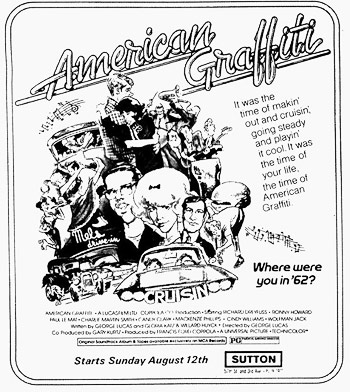
“[American Graffiti] is surely the most accurate and poetic evocation of American life since The Last Picture Show. It reminds us what fun filmmaking even with a serious purpose can be.” — Charles Brock, (Jacksonville) Florida Times-Union
“One of the top movies of 1973…funnier and more touching than Summer of ’42!” — Clyde Gilmour, Toronto Star
“The stars are nice clean-cut kids whose names probably will not be remembered.” — Fred Herman, The Modesto Bee
“A highly charged emotional experience. An absolute must for anyone who has nostalgia about growing up in the late 1950s and early 1960s. A breathless, cat’s meow of a movie with enough energy and talent to get the next man to the moon and back. Magnificently acted, edited, directed, photographed and scored.” — Rex Reed, syndicated columnist
“Brilliant, bittersweet memoir.” — Paul D. Zimmerman, Newsweek
“[American Graffiti is] not only a great movie but a brilliant work of historical fiction; no sociological treatise could duplicate the movie’s success in remembering exactly how it was to be alive at that cultural instant.” — Roger Ebert, Chicago Sun-Times
“For anyone who was growing up in the 1950s or as late as the assassination of President Kennedy which ended the era, American Graffiti is an enthralling movie, a deeply affecting experience. It will mean less to older and younger audiences, but it remains a masterful work of film art which distills adolescence, small town life, and 1950s America into one group of teen-aged friends’ final night together.” — Robert Taylor Oakland Tribune
DID YOU KNOW?
Over the course of its original release, American Graffiti had become the second-most successful movie in the history of Universal Pictures and number eleven on the industry’s all-time list of box-office champs.
The most-successful North American theatrical engagement of American Graffiti was a 63-week run at the Varscona in Edmonton, Canada. The longest run in the United States was a 54-week run at the Colorado 4 in Denver.
Instead of a formal premiere, an invitational preview of American Graffiti was held July 31, 1973, at the Directors Guild Theater in Los Angeles, before opening to the public August 1, 1973, at the Avco Center in Los Angeles.
George Lucas and his wife and parents attended the Modesto premiere at the Briggsmore Theater on November 21, 1973. Lucas was presented with a “Key to the City” by the mayor.
“Where were you in ’62?” and “It was the time of makin’ out and cruisin’; going steady and playin’ it cool. It was the time of your life… the time of American Graffiti” were slogans used on some of the film’s promotional material.
For many years, American Graffiti was the major studio movie with the highest profit-to-cost ratio.
American Graffiti was not a universally (no pun intended) liked title. Universal Pictures executive Ned Tanen’s title suggestion was Another Slow Night in Modesto. Producer Coppola suggested Rock Around the Block.
Richard Walter, a USC classmate of Lucas, wrote the early drafts of the screenplay. His drafts, however, were jettisoned and thus he was not given any on-screen credit.
Although set in the Central California city of Modesto, American Graffiti was filmed in the San Francisco Bay Area, primarily in Marin and Sonoma counties.
R2-D2, the popular character from Star Wars, was “created” during the post-production of American Graffiti when, as legend has it, sound designer and re-recording mixer Walter Murch asked a co-worker to retrieve “R2D2” (Reel Two, Dialogue Track Two).
Imitation is the sincerest form of flattery.… The success of American Graffiti, arguably, kicked off a 50s & 60s nostalgia trend in movies and television (Happy Days, Cooley High, The Lords of Flatbush, Grease, Animal House, etc.). Not long after Graffiti was released, Paramount rushed into production the Happy Days television series, which had been based upon an unsold pilot and 1972 episode of Love, American Style. (Paramount had offered to acquire Graffiti during a period of time when it appeared Universal was uninterested in releasing the movie to theaters.) Happy Days premiered in January 1974 and, of course, starred Graffiti’s Ronny Howard, and, during its first couple of seasons used Graffiti’s opening titles song, Rock Around the Clock, as its opening titles song.
A couple of filmmaker in-jokes include the license plate number on John Milner’s car (THX 138, a nod to Lucas’s first film THX 1138) and Dementia 13 (one of producer Francis Ford Coppola’s early films) listed on a movie theater marquee, despite having been released after the 1962 setting of American Graffiti.
American Graffiti was filmed in Techniscope, a half-frame 35mm format comparable in quality to 16mm, and then blown-up to an anamorphic 35mm release print format. Hundreds of low-budget movies during the 1960s and 1970s employed the Techniscope format where the filmmakers desired widescreen imagery. In the 1980s Techniscope evolved into Super Techniscope, more commonly known as Super-35. (Lucas’s THX 1138 was also filmed in Techniscope.)
For the 1978 re-release, given Lucas’s newfound clout due to the massive success of Star Wars, two minutes of footage excised from the original release by order of the studio was reinstated into the film. As well, the date of John Milner’s death in the character bio text that ends the film was changed from June 1964 to December 1964 to justify the character’s appearance in the then-in-preparation sequel. The film was also re-mixed in Dolby Stereo. (This re-release version of the film was the basis for all home-video releases to follow.)
There was a one-hour radio program, The Making of American Graffiti, prepared for the 1978 re-release. In 1998, an all-new 78-minute documentary, The Making of American Graffiti, was produced by Laurent Bouzereau and included as a supplement on the Collector’s Edition DVD and Signature Collection LaserDisc, and subsequently included on the Blu-ray Disc issued in 2011.
American Graffiti was included in a Universal Studios classic film festival held in 1998 at the Universal Amphitheater in Universal City, California. Graffiti first-draft screenwriter Richard Walter hosted the screening. (Other films screened included Fast Times at Ridgemont High, Jaws, Jurassic Park, and Psycho.)
Awards… American Graffiti was nominated for five Academy Awards, including Picture, Director, Screenplay, Supporting Actress (Candy Clark), and Film Editing. Other awards included a Blue Ribbon (from Boxoffice Magazine), a Bronze Leopard from the Locarno Film Festival, a Scholastic Magazine “Bellringer” award for “Films of outstanding interest and merit for young people,” Top Feature Picture of the Year from Media Methods Magazine, top honors from the Cartagena Film Festival and the Kansas City Film Critics Circle. The film’s screenplay was honored by the New York Film Critics Circle, National Society of Film Critics, and Young New York Film Critics Association. The screenplay was nominated by the Writers Guild. In addition to the Oscar nomination, Lucas’s direction was nominated by the Golden Globes and Directors Guild. The film won a Golden Globe for Best Musical/Comedy Motion Picture. The film is #77 on the American Film Institute’s 100 Years 100 Movies list from 1997; ten years later the AFI created a new list and moved Graffiti up to #62.
Approximately $80,000, about one-tenth of the budget, was spent on securing the rights to the 40+ songs that appeared in the movie.
In 1998, the opening shot of the movie was revised to incorporate a new, more colorful sunset. In 2011 for the Blu-ray, neon highlight was added to the opening credits.
Mort Drucker, of Mad Magazine fame, created the artwork used on the film’s promotional material.

There were numerous test screenings of American Graffiti in the months leading up to its release. The most significant (and legendary) screenings took place January 28, 1973, at the Northpoint in San Francisco, and May 15, 1973, at the Writers Guild in Beverly Hills.
In 1995, American Graffiti was selected for preservation by the National Film Registry of the Library of Congress, for being “culturally, historically or aesthetically significant.”
American Graffiti was shot in 28 days between June 26 and August 4, 1972, but it would be a whole year before it would get released due to numerous test screenings, disagreements between the studio executives and the filmmakers over the film’s running time and use of songs, a Writers Guild strike, and the studio’s indecisiveness on how to handle its release.
In 1997, an American Graffiti-inspired sculpture was erected at George Lucas Plaza in downtown Modesto depicting a teenage boy and girl next to a ’57 Chevy.
On July 17, 1998, a 25th anniversary screening plus cast & crew reunion and Q&A was held at the Samuel Goldwyn Theater in Beverly Hills.
American Graffiti’s network television broadcast premiere was February 18, 1979, on NBC. Its first home-video release was in 1979. Its first letterboxed release (on LaserDisc) was in 1996. A “Signature Collection” LaserDisc set was issued in 1998. The film was first issued on DVD in 1998 and on Blu-ray Disc in 2011.
George Lucas was the Grand Marshall of the 15th annual Modesto American Graffiti Car Show and Festival parade held June 7, 2013.
NUMBER$:
- 1 = Number of theaters showing the movie during opening weekend
- 1 = Number of sequels
- 2 = Rank among Universal’s top-grossing movies at close of original run
- 3 = Rank among top-grossing movies of 1973 (legacy)
- 10 = Rank among top-grossing movies of 1973 (calendar year)
- 11 = Rank on all-time list of top-grossing movies at close of original run
- 28 = Number of days of principal photography
- 44 = Rank on current list of all-time to-grossing movies (adjusted for inflation)
- 428 = Rank on current list of all-time top-grossing movies
--
- $35,000 = Opening week box-office gross
- $750,000 = Production cost
- $3.9 million = Production cost (adjusted for inflation)
- $8.6 million = Box-office rental of 1978 re-release
- $10.3 million = Box-office rental through end of 1973 calendar year
- $25.0 million = International box-office gross
- $47.3 million = Box-office rental of original release
- $55.9 million = Box-office rental of original + re-release
- $115.0 million = Cumulative domestic box-office gross of original + re-release
- $140.0 million = Cumulative worldwide box-office gross
- $586.2 million = Cumulative all-time domestic box-office gross (adjusted for inflation)
- $713.6 million = Cumulative all-time worldwide box-office gross (adjusted for inflation)
PRINCIPAL CAST & CREW:
- Curt – Richard Dreyfuss
- Steve – Ronny Howard
- John – Paul Le Mat
- Terry – Charlie Martin Smith
- Debbie – Candy Clark
- Carol – Mackenzie Phillips
- Laurie – Cindy Williams
- Disc Jockey – Wolfman Jack
- Joe – Bo Hopkins
- Bob Falfa – Harrison Ford
- Carlos – Manuel Padilla, Jr.
- Peg – Kathleen Quinlan
- Blonde in T-Bird – Suzanne Somers
- Herby and the Heartbeats – Flash Cadillac and the Continental Kids
--
- Director – George Lucas
- Screenplay – George Lucas and Gloria Katz & Willard Huyck
- Co-Producer – Gary Kurtz
- Producer – Francis Ford Coppola
- Casting – Fred Roos and Mike Fenton
- Sound Montage and Re-Recording – Walter Murch
- Film Editors – Verna Fields and Marcia Lucas
- Visual Consultant – Haskell Wexler
- Directors of Photography – Ron Eveslage, Jan D’Alquen
- Art Director – Dennis Clark
- Costume Designer – Aggie Guerard Rodgers
--
- Distributor – Universal Pictures
- Production Company – Lucasfilm Ltd. / Coppola Co.
- Release Date – August 1, 1973
- Running Time – 110 minutes (1973) / 112 minutes (1978 re-release)
- Projection Format – Scope / Mono (1973), Dolby Stereo (1978 re-release)
- MPAA Rating – PG
SOURCES/REFERENCES:
The information contained in this article was principally referenced from newspaper and film industry trade publication articles, film reviews and theater advertisements. Selected information was referenced from the books George Lucas’s Blockbusting: A Decade-by-Decade Survey of Timeless Movies Including Untold Secrets of Their Financial and Cultural Success (Alex Ben Block, editor; George Lucas Books/HarperCollins; 2010), George Lucas: A Biography (John Baxter, HarperCollins, 1999), George Lucas: Interviews (Sally Kline, editor; University Press of Mississippi; 1999), George Lucas: The Creative Impulse (Charles Champlin, Abrams, 1992), George Lucas: The Making of his Movies (Chris Salewicz, Orion Media, 1998), The Movie Business Book (Jason E. Squire, editor; Fireside; 1988), George Lucas (James Clarke, Pocket Essentials, 2002), Skywalking: The Life and Films of George Lucas (Dale Pollack, Harmony, 1983), Star Wars: Year by Year A Visual Chronicle (Dorling Kindersley/Lucasfilm; 2010), and the motion pictures American Graffiti (1973, Universal Pictures) and The Making of American Graffiti (1998, Universal Studios Home Video). Images copyright 1973 Universal Pictures.
SPECIAL THANKS:
Jerry Alexander, Jim Barg, Raymond Caple, Nick DiMaggio, Mike Durrett, Bill Gabel, Sheldon Hall, John Hazelton, Bill Kretzel, Mark Lensenmayer, Stan Malone, Gabriel Neeb, Tim O’Neil, Jim Perry, John Stewart, Vince Young, and to all of the librarians who helped with the research for this project.
IN MEMORIAM:
Verna Fields (editor), 1918-1982
Wolfman Jack (“Disc Jockey”), 1938-1995
Johnny Weissmuller Jr. (“Badass #1”), 1940-2006
Manuel Padilla, Jr. (“Carlos”), 1955-2008
Ned Tanen (Universal executive), 1931-2009
- Michael Coate


